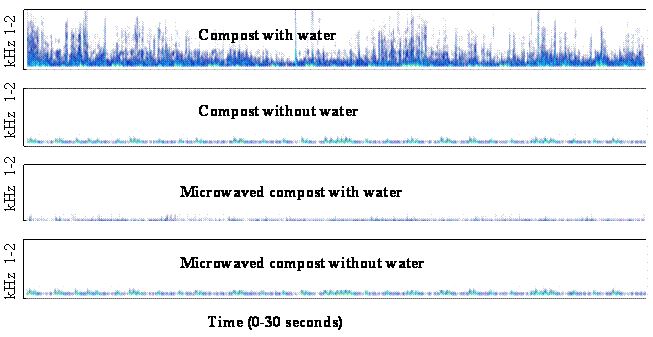Compost Biology and Acoustics
Impact of microwaves and water on acoustical signatures of a compost
Sounds and Spectograms
The acoustics of four states of a compost were analyzed. Compost (200 cm3), made from leaves and kitchen refuse, with its natural biota (earthworms, Isopods, Collembola, Staphilinid beetles, nematodes and other microscopic organisms) was placed in two 400 ml glass containers. One was microwaved in a “Sharp Carousel R-326FS” model microwave for two minutes, with an output power of 1100W, and the frequency 2450 MHz. A hydrophone (Aquarian AQ3) was place on a 35° angle on the compost surface in both containers and the sounds recorded for 30 seconds in a sound-insulated chamber. The process was repeated five times. Subsequently, 50 ml of water was added to both the original and microwaved compost. The resulting acoustics were recorded as described above. The compost was moist (~40% moisture) and at room temperature (~21 Co). The activities of the macro-invertebrates were also visually observed.
Sounds of Compost (non-microwaved) with water added as an activating agent (to hear the sound click on the replication number): replication 1, 2, 3, 4, 5 and 6
Sounds of compost (non-microwaved) without water added: replication 1, 2, 3, 4, and 5
Sounds of microwaved compost with water added: replication 1, 2, 3, 4, and 5
Sounds of microwaved compost without water added: replication 1, 2, 3, 4, and 5
Fig 1. Sonograms (spectrograms) of sounds of non-microwaved and microwaved compost with and without water as an activating agent. The x axis is 30 seconds time and the y axis represents kHz levels 1-2. The color intensity and brightness indicates loudness. Replicates one are shown in the sonograms.




 Print
Print Email
Email